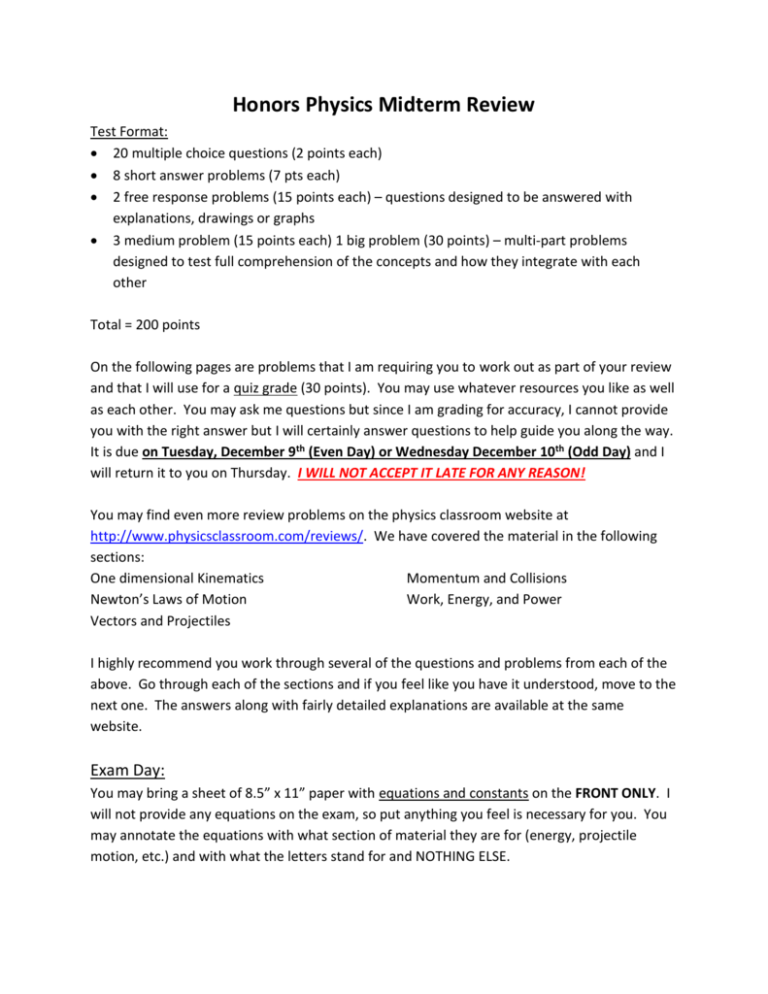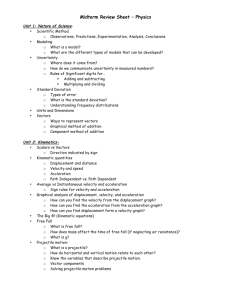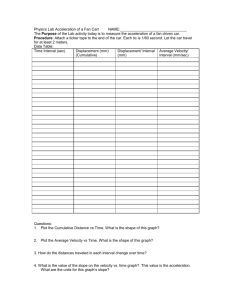Honors Physics Midterm Review Problems
advertisement

Honors Physics Midterm Review Test Format: 20 multiple choice questions (2 points each) 8 short answer problems (7 pts each) 2 free response problems (15 points each) – questions designed to be answered with explanations, drawings or graphs 3 medium problem (15 points each) 1 big problem (30 points) – multi-part problems designed to test full comprehension of the concepts and how they integrate with each other Total = 200 points On the following pages are problems that I am requiring you to work out as part of your review and that I will use for a quiz grade (30 points). You may use whatever resources you like as well as each other. You may ask me questions but since I am grading for accuracy, I cannot provide you with the right answer but I will certainly answer questions to help guide you along the way. It is due on Tuesday, December 9th (Even Day) or Wednesday December 10th (Odd Day) and I will return it to you on Thursday. I WILL NOT ACCEPT IT LATE FOR ANY REASON! You may find even more review problems on the physics classroom website at http://www.physicsclassroom.com/reviews/. We have covered the material in the following sections: One dimensional Kinematics Momentum and Collisions Newton’s Laws of Motion Work, Energy, and Power Vectors and Projectiles I highly recommend you work through several of the questions and problems from each of the above. Go through each of the sections and if you feel like you have it understood, move to the next one. The answers along with fairly detailed explanations are available at the same website. Exam Day: You may bring a sheet of 8.5” x 11” paper with equations and constants on the FRONT ONLY. I will not provide any equations on the exam, so put anything you feel is necessary for you. You may annotate the equations with what section of material they are for (energy, projectile motion, etc.) and with what the letters stand for and NOTHING ELSE. Review Problems Multiple Choice: 1. Which of the following statements is true? (A) Displacement is a scalar and distance is a vector. (B) Displacement is a vector and distance is a scalar. (C) Both displacement and distance are vectors. (D) Neither displacement nor distance are vectors. (E) Displacement and distance are always equal. Questions 2-3: Consider the velocity vs time graph below: 2. A which time(s) is the object at rest? (A) zero (B) 1 s (C) 3 s to 4 s (D) 4 s only (E) 8 s 3. During which interval is the speed of the object decreasing? (A) 0 to 1 s (B) 1 s to 3 s (C) 3 s to 4 s (D) 4 s to 8 s (E) the speed of the object is never decreasing in this graph 4. An object with mass m is being pushed along a rough surface at a constant velocity. Which of the following statements is FALSE? (A) The net force is zero (B) The work done by gravity is zero (C) The normal force is equal to the weight (D) The frictional force is equal to the normal force (E) The frictional force is equal to the applied force 5. Which of these is NOT true of work? (A) It is the scalar product of force and displacement. (B) It is measured in joules. (C) It has the same units as energy. (D) It is a vector which is always in the same direction as the displacement. (E) It takes energy to perform work Short problems: 6. The resultant of two displacement vectors 30 m east and 40 m south is 7. A train accelerates from rest with an acceleration of 4 m/s2 for a time of 20 s. What is the train’s speed at the end of 20 s? Questions 8-10: A ball is thrown straight upward with an initial speed of +12 m/s. 8. What is the ball’s acceleration just after it is thrown? 9. What is the approximate maximum height the ball reaches? 10. How much time does it take before it comes back down to its original height? 11. A 4-kg box is pushed across a level floor with a force of 60 N for a distance of 20 m, then lifted to a height of 2 m. What is the total work done on the box? 12. A block of mass 1 kg slides with a speed of 3 m/s on a frictionless surface and collides with another mass (M) which is initially at rest. The two blocks stick together and move with a speed of 1 m/s. What is M? Medium problems 13. A Gold Car moving at 12.0 m/s passes a Green Car while the Green Car is at rest at a stoplight. The Green Car immediately accelerates at a rate of +1.80 m/s2 for 11.0 seconds and then maintains a constant speed. After how much time (relative to the initial starting time) must the Green Car drive before catching up with the Gold Car. Hint: figure out where each car is after 11 seconds and what speed it is travelling. Then figure out how much further they have to go for the Green car to catch up. 14. A 1-kg block rests on a frictionless table and is connected by a light string to another block of mass 2 kg. The string is passed over a pulley of negligible mass and friction, with the 2 kg mass hanging vertically. What is the acceleration of the masses? 15. A toy is designed to pop up after being pushed down. It is based on a spring with a spring constant of 100 N/m. It has a mass of 0.05 kg and when pushed down, the spring compresses 0.1 m. How fast does it go when initially released? How high will the toy travel? Explanations, Drawings and Graph problems: 17. (15 points) A cart on a long horizontal track can move with negligible friction to the left or to the right. During the time intervals when the cart is accelerating, the acceleration is constant. The acceleration during other time intervals is also constant, but may have a different value. Data is taken on the motion of the cart, and recorded in the table below. Displacement x(m) 2 Velocity v(m/s) -4 -2 -2 -2 1 1 0 time t(s) 0 1 2 3 6 7 9 0 10 (a) Plot these data points on the v vs t graph below, and draw straight lines between each data point connecting each data point to the one before it. (b) List all of the times between t = 0 and t = 10 s at which the cart is at rest. (c) On the following graph, sketch the acceleration vs. time graph for the motion of this cart from t = 0 to t = 10 s. 18. Two planetary explorers land on an uncharted planet and decide to test the range of cannon they brought along. When they fire a cannonball with a speed of 100 m/s at an angle of 25˚ from the horizontal ground, they find that the cannonball follows a parabolic path and takes 10 seconds to return to the ground. (a) List and label the known variables in the problem (b) What physics concepts would be useful in solving this problem? (c) Explain, in words only, how you might use the information given to determine the acceleration due to gravity on this planet. Big problem: 19. A block of mass 2 kg is loaded against a spring (k = 1000 N/m) that is compressed 0.2 m. k = 0.2) a distance of 2 m before being launched off the side of a table that is 1 meter above the ground. (a) Draw a diagram and label appropriately. (b) What is the initial velocity of the block immediately after being released from the spring? (c) What is the velocity of the block just before it leaves the table? (d) How far from the table does the block land?





